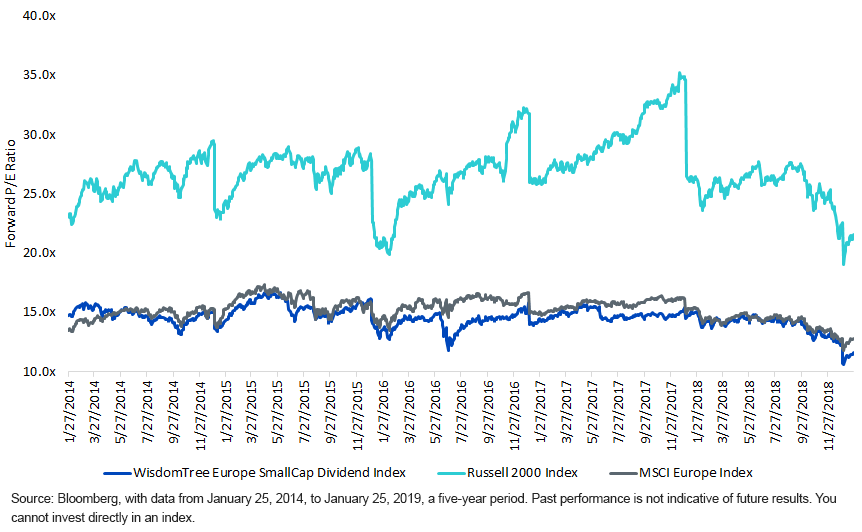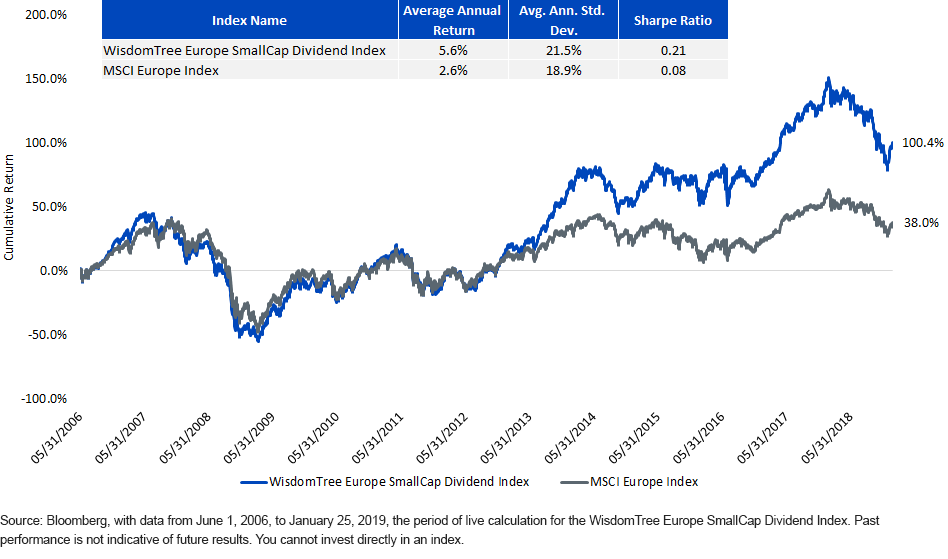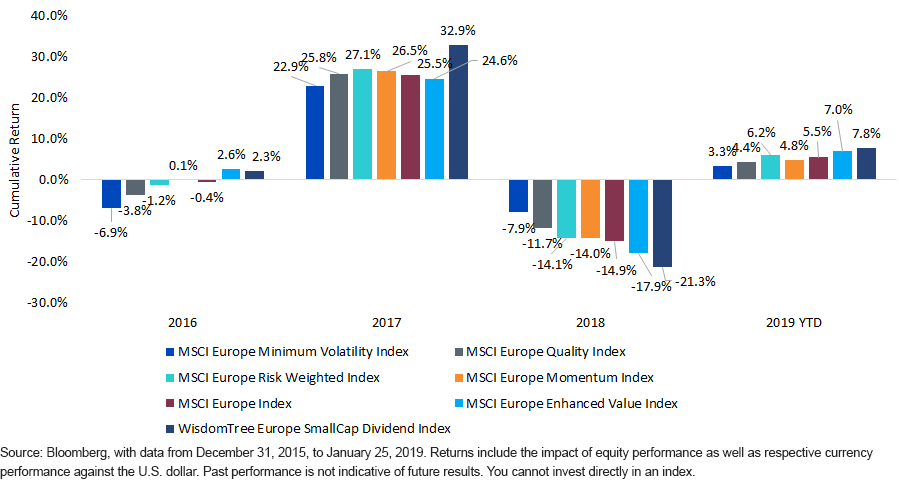Will 2019 Be the Year of Small Caps (in Europe)?


I admit it—I was stunned by January’s turnaround in market performance.
It seemed logical to consider a more defensive approach. And if someone had asked me if it was appropriate to over-weight small-cap equities, I wouldn’t have had the guts to say yes after being shell-shocked by the VIX spiking to 36 in late December.
But small caps have been off to an incredible start in 2019.
What’s Easy? Slipping into Old Patterns
With the current global backdrop, a U.S. allocation is one of the easiest to create a compelling narrative around. The Brexit uncertainty in Europe, for example, is enough to buttress this narrative. The Russell 2000 Index has started 2019 off strongly, delivering a double-digit return in January. There is little question that investors will notice.
But it’s important to remember that small-cap companies tend to be businesses with long-term goals, and U.S. growth is currently late in its cycle. So, while it may be possible to squeeze further positive performance from small caps, there isn’t much in the way of a valuation cushion, should conditions deteriorate.
- The lower risk of U.S. small caps should lead to the Russell 2000 Index having a higher forward P/E multiple—a factor that is not in dispute. The real question is, given the balance of risks, how much higher should the multiple be than, say, that of the WisdomTree Europe SmallCap Dividend Index? What we see in figure 1 is something on the order of 50%.
- The forward P/E ratios of the WisdomTree Europe SmallCap Dividend Index and the MSCI Europe Index have been quite similar, with the WisdomTree Index having the current advantage.
Figure 1: European Small Caps Offer a Massive Discount over U.S. Small Caps

European Small Caps Are Impossible to Ignore
Since 2013, the WisdomTree Europe SmallCap Dividend Index has opened up a dramatic performance gap over the MSCI Europe Index. This illustrates an important point, especially since we recognize that when investors look beyond the U.S., they often look only at large caps. The key explanations of this opportunity for small caps in Europe are:
- When risks arise in Europe, they’re frequently expressed through volatile performance by some of the large, systemically important banks. These banks have large market capitalizations, thereby commanding large weights in indexes such as the MSCI Europe Index. By looking to small caps, investors can avoid the systemically important financials, at least in terms of direct index exposure.
- There have been two distinct periods when oil prices dropped significantly over short periods of time. A focus on small caps would tend to tilt away from these larger companies that have had some more difficult periods since 2013.
As investors consider European equities, we’d emphasize the importance of not forgetting the full spectrum of market capitalization.
Figure 2: Long-Term Performance of European Small Caps Has Been Very Strong

Relief Rally in 2019?
We recognize that we have to face the facts. Global growth is trending slower than it has in recent years, hampered in part by the U.S. tax cut impact from 2017. And sentiment toward Europe’s growth is not particularly strong at present. 2017 was a much better year.
Fortunately, the relationship between economic growth and equity performance is not a simple correlation.
- In 2016, Europe’s equities were searching for footing after such surprises as the Brexit referendum result and Trump’s presidential election victory.
- If every year were like 2017, European equities would dominate people’s portfolio exposures. Economic growth data was accelerating, equity performance was strong, and the European currencies were appreciating against the U.S. dollar.
- It is strange to have to put 2017 and 2018 side by side. In 2018, there was massive deceleration in economic growth prospects for Europe, as well as declining sentiment.
- To be fair, growth isn’t exactly accelerating as we start 2019. But there does appear to be a relief rally underway. It’s intriguing that the WisdomTree Europe SmallCap Dividend Index was the worst performer in 2018, but in 2019, it has started off the most strongly (not to mention the fact that every factor index is positive so far).
Figure 3: Understanding Europe’s Equity Markets through the Factors

Don’t Forget about Europe’s Small Caps
As we’ve said before, it’s easier to make the case to allocate to the U.S. over Europe today. However, we don’t believe investors realize that each of the five major factor-focused indexes of Europe have been positive in January of 2019 after quite a rough year. European small caps have delivered strong performance in the long term and currently offer a large discount over U.S. equities. That’s where we see an opportunity.

Christopher Gannatti began at WisdomTree as a Research Analyst in December 2010, working directly with Jeremy Schwartz, CFA®, Director of Research. In January of 2014, he was promoted to Associate Director of Research where he was responsible to lead different groups of analysts and strategists within the broader Research team at WisdomTree. In February of 2018, Christopher was promoted to Head of Research, Europe, where he was based out of WisdomTree’s London office and was responsible for the full WisdomTree research effort within the European market, as well as supporting the UCITs platform globally. In November 2021, Christopher was promoted to Global Head of Research, now responsible for numerous communications on investment strategy globally, particularly in the thematic equity space. Christopher came to WisdomTree from Lord Abbett, where he worked for four and a half years as a Regional Consultant. He received his MBA in Quantitative Finance, Accounting, and Economics from NYU’s Stern School of Business in 2010, and he received his bachelor’s degree from Colgate University in Economics in 2006. Christopher is a holder of the Chartered Financial Analyst Designation.

